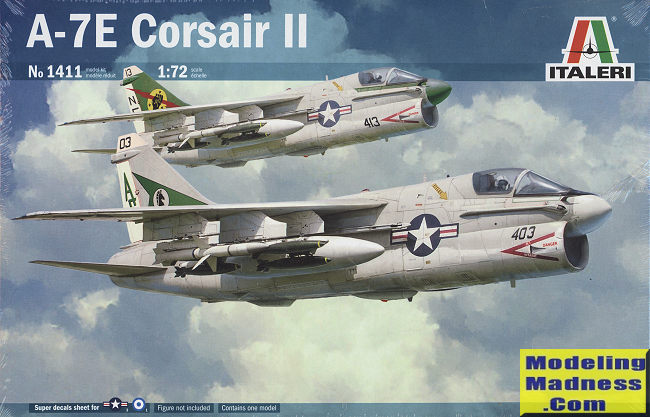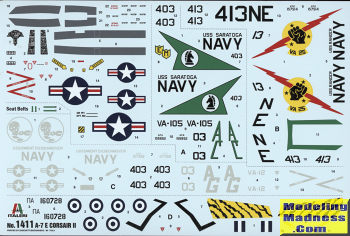
Italeri 1/72 A-7E Corsair II
| KIT #: | 1411 |
| PRICE: | $18.99 |
| DECALS: | Four options |
| REVIEWER: | Scott Van Aken |
| NOTES: | 2018 boxing |

| HISTORY |
The Navy was sufficiently impressed with the increased power offered by the A-7D Spey engine used by the Air Force, and decided to use this engine for its own version of the Corsair II. The designation A-7E was assigned, and this version was to succeed the A-7B in production. However, there were delays in the deliveries of the TF41-A-2 engine specified for the A-7E, so the first 67 aircraft of the order were delivered with the TF30-P-8 engine. These aircraft had all of the other improvements planned for the A-7E, including the improved avionics and the M61 rotary cannon, and were re-designated A-7C after delivery.
The first Spey-powered A-7E flew for the first time on 9 March 1969. The A-7E differed from the USAF A-7D in retaining the probe-and-drogue midair refueling system of the earlier A-7A/B. It entered service in Southeast Asia in May 1970 with VA-146 and VA-147 deployed aboard USS America. The A-7E participated in numerous close-air support missions over both North and South Vietnam, the A-7E's state-of-the-art bombing and navigation system being particularly reliable and accurate. Most air wings operating Douglas A-4 Skyhawks and early A-7s were re-equipped with A-7Es. The A-7E participated in the mining of Haiphong harbor in 1972, and played a vital role in Operations Linebacker I and Linebacker II that led up to the formal end of US involvement in the Vietnam War on 24 January 1973.
The A-7E went on to provide the fleet with light attack capabilities in many small conflicts during the 70's and 80's, culminating in the last two active squadrons participating in Desert Storm before being deactivated in 1991. Its replacement was the legacy Hornet, a multi-role aircraft that could do none of its roles as well as a dedicated airframe.
| THE KIT |
 This
is an ex-ESCI kit from the mid 1980s and still holds up fairly well, when
compared to the best 1/72 A-7 series on the market, the Fujimi kit of the late
1980s. It is not as petite in its detail, but that also means that it is easier
to build.
This
is an ex-ESCI kit from the mid 1980s and still holds up fairly well, when
compared to the best 1/72 A-7 series on the market, the Fujimi kit of the late
1980s. It is not as petite in its detail, but that also means that it is easier
to build.
Like the Fujimi kit, it has a fairly nice cockpit though could benefit from a replacement seat. It has a full weapons load of snakeyes along with MERs and TERs. It also has the correct wheels and the different antennas not carried by the A-7A/B. A pair of drop tanks are also included with the kit. Often as not, these tanks only had the lower fin.
It does have its issues. For one the intake is less than an inch deep and the forward section is made of two pieces rather than relying on one. Gear wells are also a bit generic and holes for the pylons are already open so you can't do a clean wing without doing some filling. However, these planes almost always carried all of the wing pylons and often the fuselage one for the Sidewinders even when there was nothing attached. One thing I like, because I'm lazy, is that an intake cover is on the sprues. You will note some USAF-only weapons on the sprues such as the HARM and Maverick missiles. Even after all the different pressings, the sprues are still in very good condition.
 Instructions
are now in booklet form and provide Italeri acrylic paint info. The four
markings options are in full color in the instructions. There are three USN
options and one Greek. Two of the USN options are in the light gull grey and
white scheme with one being VA-105 and the other VA-25. An overall flat ghost
grey plane from VA-12 rounds out the USN options. The Greek plane is in the SEA
camouflage scheme. The A-7H has full USN equipment, including the air refueling
probe, but does not have the cat bar on the nose gear so you will want to remove
that. Some references state that the A-7H had no inflight refuelling probe, but
this is pretty well incorrect. I found one photo out of hundreds on line that
was without it. That was a TA-7H photographed when the planes were still new so
obviously they had the system installed or most were delivered with it. Decals
are excellent and quite usable. They include fuselage walk areas and
instruments.
Instructions
are now in booklet form and provide Italeri acrylic paint info. The four
markings options are in full color in the instructions. There are three USN
options and one Greek. Two of the USN options are in the light gull grey and
white scheme with one being VA-105 and the other VA-25. An overall flat ghost
grey plane from VA-12 rounds out the USN options. The Greek plane is in the SEA
camouflage scheme. The A-7H has full USN equipment, including the air refueling
probe, but does not have the cat bar on the nose gear so you will want to remove
that. Some references state that the A-7H had no inflight refuelling probe, but
this is pretty well incorrect. I found one photo out of hundreds on line that
was without it. That was a TA-7H photographed when the planes were still new so
obviously they had the system installed or most were delivered with it. Decals
are excellent and quite usable. They include fuselage walk areas and
instruments.
| CONCLUSIONS |
I've built a bunch of these in both the D and E variant and while they do have their quirks, they build into nice models that anyone who likes the type will be happy to have on their shelves. The only thing that changes over the years are the markings and the price.
| REFERENCES |
https://en.wikipedia.org/wiki/LTV_A-7_Corsair_II
October 2019 Copyright
ModelingMadness.com. All rights reserved. If you would like your product reviewed fairly and fairly quickly, please
contact
the editor
or see other details in the
Note to
Contributors.
Back to the Main Page
Back to the Review
Index Page
Back to the Previews Index Page